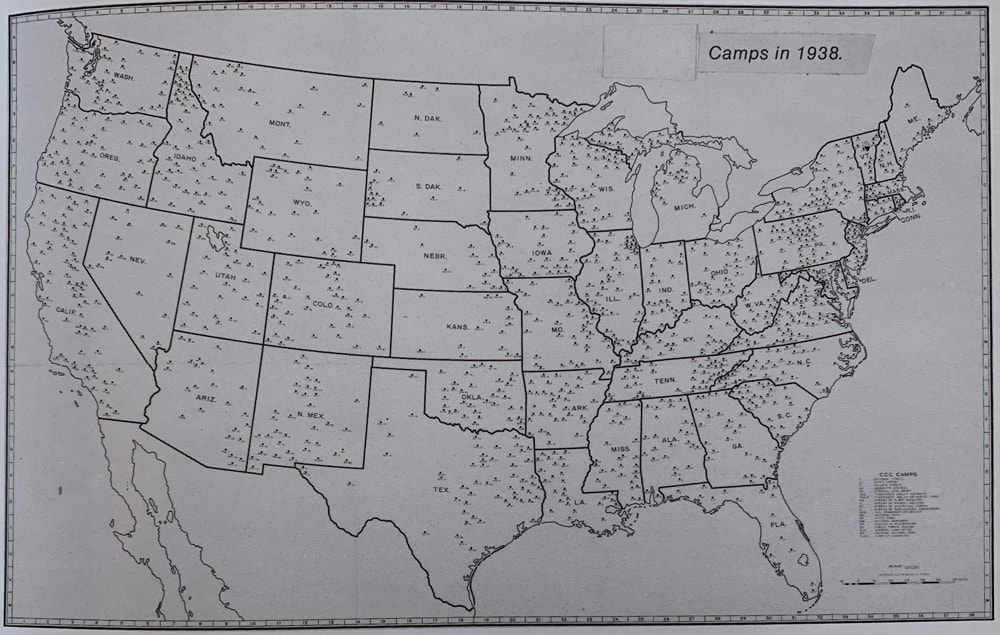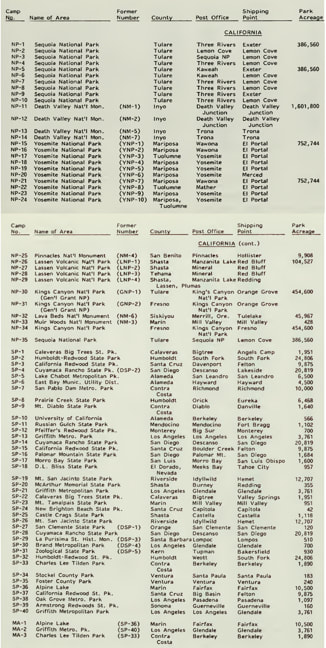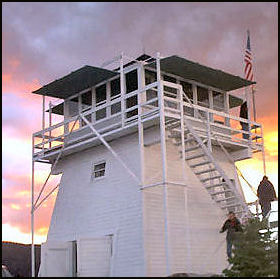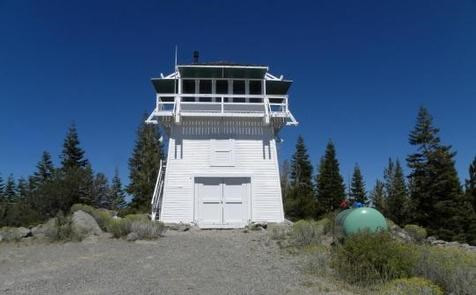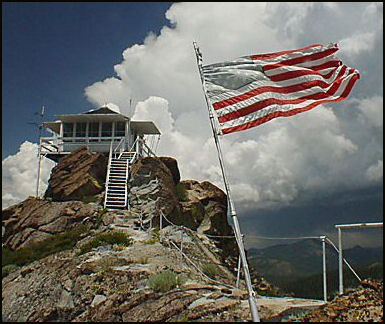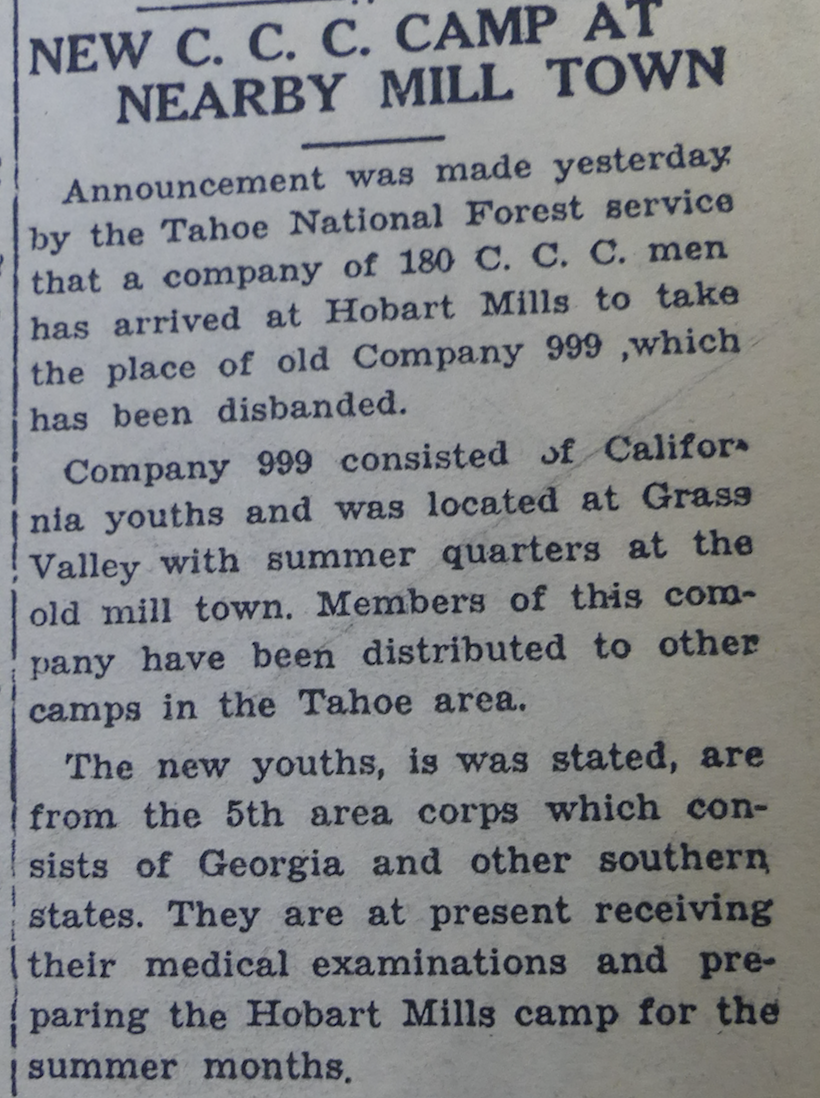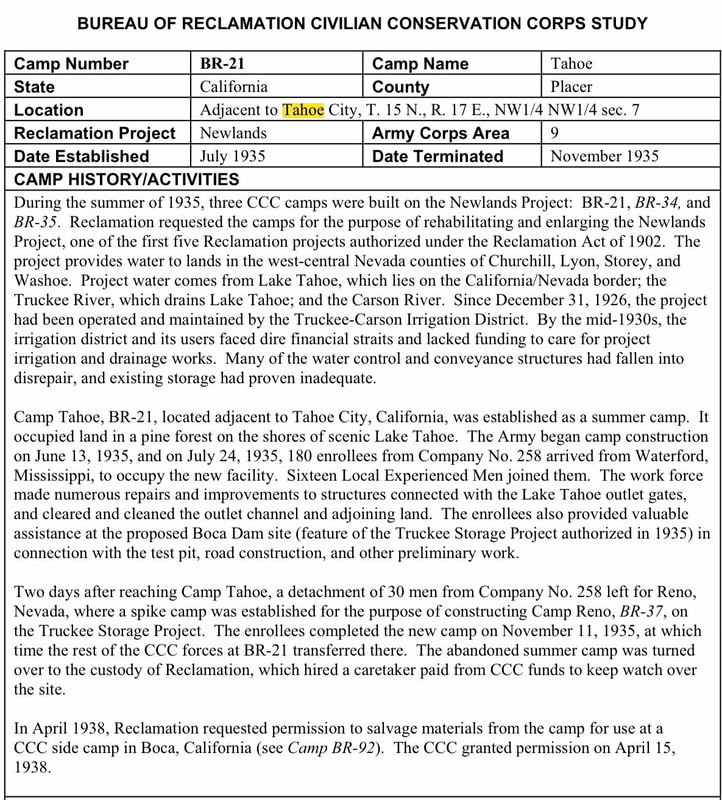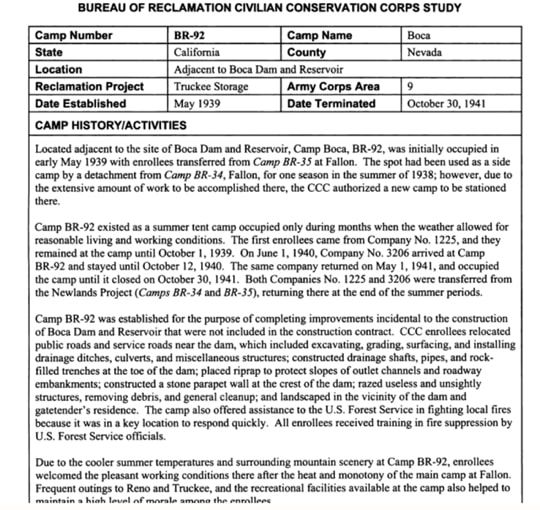The Civilian Conservation Corps (CCC) and Fire Lookouts by Heidi Sproat
Now that we’re all stuck at home, and we’re trying to think up things we should and could be doing when we can, when it comes right down to it, why not just pretend you’re out exploring - instead of doing so online. So instead of cleaning out my closet, or organizing the kitchen cabinets, why not have some online educational fun. But WHY would anyone want to do any research about some government program from the 1930s?
Ever heard of the Civilian Conservation Corps (CCC)? Even if you haven’t, there are probably a dozen places you’ve been in California that were built, upgraded, or overhauled by the CCC “Boys”. And even if you haven’t visited such an area, know that many of the fire-fighting programs in California have their genesis in the CCC efforts to quell Sierra Nevada fires in the 1930s – a possible forerunner to the Truckee Hotshots. 1
A Little Background
Most of us are familiar with the CCC as part of a New Deal program implemented by President Franklin D. Roosevelt in an effort to get the staggering number of unemployed young men engaged in meaningful, productive, employable work. After the Great Depression, years of natural disasters, and very poor land management practices, FDR’s “Tree Army,'' the CCC, was conceived and approved by Congress in 1933. Unmarried men between the ages of 18-25 whose family was on relief, could join the CCC for a six-month stint working in a CCC camp. Enrollees could re-up for a maximum of two years. Most CCC camps had 200 enrollees. Most of the work was hard physical labor, but as FDR said:
Ever heard of the Civilian Conservation Corps (CCC)? Even if you haven’t, there are probably a dozen places you’ve been in California that were built, upgraded, or overhauled by the CCC “Boys”. And even if you haven’t visited such an area, know that many of the fire-fighting programs in California have their genesis in the CCC efforts to quell Sierra Nevada fires in the 1930s – a possible forerunner to the Truckee Hotshots. 1
A Little Background
Most of us are familiar with the CCC as part of a New Deal program implemented by President Franklin D. Roosevelt in an effort to get the staggering number of unemployed young men engaged in meaningful, productive, employable work. After the Great Depression, years of natural disasters, and very poor land management practices, FDR’s “Tree Army,'' the CCC, was conceived and approved by Congress in 1933. Unmarried men between the ages of 18-25 whose family was on relief, could join the CCC for a six-month stint working in a CCC camp. Enrollees could re-up for a maximum of two years. Most CCC camps had 200 enrollees. Most of the work was hard physical labor, but as FDR said:
The overwhelming majority of unemployed Americans … would infinitely prefer to work. We can take a vast army of these unemployed out into healthful surroundings. We can eliminate to some extent at least the threat that enforced idleness brings to spiritual and moral stability. March 21, 1933
While the CCC program was intended primarily to be a conservation program, the added bonus was that the camps curtailed the exploding unemployment rate among young capable men. There was significant tree planting, construction of living units, buildings, water, sewer, and electrical systems, trail clearing and creation, road construction, fire prevention, brush clearing, and stone laying. An added bonus the CCC provided was educational in that each enrollee received at least six hours of training a week. Given the war raging in Europe, the CCC camp training was also preparedness – militarily. Military drilling and specialized classes like welding were also offered to enrollees and in hindsight, proved invaluable in the war effort.
By the summer of 1933, the CCC had enrolled 270,000 young single men to work in 1,330 camps around the country. 2 (Wehrle, p. 181). Of the assigned nine areas designated in the US, there were at its peak, 4,000 camps in 48 states.
By the summer of 1933, the CCC had enrolled 270,000 young single men to work in 1,330 camps around the country. 2 (Wehrle, p. 181). Of the assigned nine areas designated in the US, there were at its peak, 4,000 camps in 48 states.
Here is a map of the CCC camps in the United States in 1938.
In a definitive 1995 Administrative History report issued by the National Park Service, Department of the Interior, author John Paige, California CCC camps included Sequoia National Park, Death Valley National Monument, Yosemite National Park, Pinnacles National Monument, and Lassen Volcanic National Park, among almost four dozen other sites, BUT only one site is listed in Nevada County (and El Dorado County), D.L. Bliss State Park. There do not appear to be other CCC “camps” in place in California in the 1930s, but the listing of California CCC camps in the CCC Legacy online database provides dozens of other camps. We just haven’t found details yet. Even checking the state of Nevada, only Boulder Dam National Recreation Area, Cathedral Gorge State Park, and Fort Churchill State Park were mentioned. (See list below).
|
Note: If you click on many of the images, you will be able to view a larger image.
All photos courtesy of the Author, unless otherwise identified. Ironically, out bike riding on the other side of the country, I came across a host of CCC monuments and restored buildings. 3 Although born and raised in Oakland, California in my childhood, I can still recall my father energized about this CCC government program that put young unemployed men to work in the face of dire economic consequences of the Great Depression. I can recall him explaining to us four kids how many of the places we would visit up and down the west coast, towards the Sierra Nevada, and on our various road trips back to his home state of Minnesota, were touched by the CCC “Boys to Men’s" hands.
While researching details surrounding the erection of the Truckee Veterans Memorial Building, I kept coming across publications that mentioned CCC involvement in local areas. And then the Tahoe Donner September 2019 newsletter (p. 19) 4 had a photo of a group of TD 4Wheelers that recently visited Saddleback Fire Lookout. In that photo was the memorial plaque crediting the CCC with erection in 1934. That was it; I just had to find out more information.
|
Fire Lookouts
Saddleback Fire Lookout is about 10 miles northwest of the town of Downieville. Calpine Fire Lookout was built in 1934 by the CCC; another Pilot Peak, Plumas County. Clearly, in the 1930s the CCC activity in forested areas was centered on fire prevention, fire-fighting, and fire-suppression. I thought maybe the Sierra Buttes fire lookout was also constructed by the CCC, but learned after a site visit that it was erected some 15 years earlier, in 1915; BUT there is mention of a 1933 build (expansion) date. Wonder if the CCC was also involved in this upgrade? Sardine Peak lookout was also built by the CCC in 1934. 5 In fact, it was at one of these very kinds of lookouts that one of the first female fire rangers, Lane Endicott, served. (See this article for details. 6) List of Fire Lookouts in California; Former Fire Lookout Sites Register. 7 In 2020, many of these fire lookouts can be rented through a national reservation system at Recreation.gov.
Saddleback Fire Lookout is about 10 miles northwest of the town of Downieville. Calpine Fire Lookout was built in 1934 by the CCC; another Pilot Peak, Plumas County. Clearly, in the 1930s the CCC activity in forested areas was centered on fire prevention, fire-fighting, and fire-suppression. I thought maybe the Sierra Buttes fire lookout was also constructed by the CCC, but learned after a site visit that it was erected some 15 years earlier, in 1915; BUT there is mention of a 1933 build (expansion) date. Wonder if the CCC was also involved in this upgrade? Sardine Peak lookout was also built by the CCC in 1934. 5 In fact, it was at one of these very kinds of lookouts that one of the first female fire rangers, Lane Endicott, served. (See this article for details. 6) List of Fire Lookouts in California; Former Fire Lookout Sites Register. 7 In 2020, many of these fire lookouts can be rented through a national reservation system at Recreation.gov.
So in wanderings through fire lookouts, CCC sites, WPA (Works Progress Administration) sites, I hit the ball out of the park – locally so to speak. Although the WPA supposedly completed projects in the Tahoe National Forest work area starting in 1936, the source reads as though the CCC was involved in forest improvement and development and the installation of a communication system (in 1936?), “Alder Creek to Crystal Peak, Nevada & Sierra Counties.” Details explain that workers cleared trees and brush of 61 acres of land adjacent to highways and roads. In this site is a corresponding map which purportedly shows work on Alder Creek Road!
In reviewing various articles for other research projects, I also came across these pertinent references to a CCC camp at Hobart Mills. Truckee, F-70 #503 6/26/1933 Truckee, F-396 Project #914, 8/16/1941 Truckee Hobert [sic] Mills 6 m. N, and Truckee F-399, Project #999, 6/18/1940, Truckee Hobart Mills 6 M. N. [F signifies Forestry.] Yet this CCC legacy site still refers to several Truckee camps. But specifically, where were they? Still researching.
Although a partial Truckee Republican (TR) newspaper collection currently resides at cdnc.ucr.edu, it unfortunately only goes until 1923. When it was possible to do so, I made an in-person visit to view the old records about the CCC in the Truckee area. To wit, an 1 April 1939 Madera Tribune article stated that there was to be a new CCC camp in Truckee, Nevada County. And later, in an 29 April 1941 San Bernardino Sun article, the CCC camp was to be “reestablished” in Truckee. But trying to find definitive information about any CCC camps in the Truckee area has, to date, proved to be fleeting.
There were CCC camps involved in the construction of Boca Dam, but that occurred in the late 1930s. When libraries were open, before the coronavirus upended all sorts of research plans, doing research on the CCC in the Frederick, MD area, I came upon several unique sources that assisted in my research. One of those resources was the book The CCC In Nevada From Boys to Men. Young CCC men at Boca cleared the future Boca reservoir site of willows, logs and debris. They also repaired existing roads and realigned roads that would be inundated once Boca Reservoir was completed.
|
(Far left) 6 April 1939 Truckee Republican (TR) article about the Army being in charge of the new CCC camp at Hobart Mills; (second left) 31 August 1939 TR; (third article) 1 August 1940 TR; and yet a fourth (far right) 11 July 1940 TR article about Hobart Mills CCC camp.
|
A Little Humor Goes a LONG Way Sidebar:
Each of the 3,000 CCC camps had its own internal newspaper for its own “enrollees”. Many of these camp newspapers names are quite humorous. Some of the more amusing CCC camp newspaper names: The Ash Can, Bath tub Leaks, Boca del Inferno, The Cammal’s Hump, The Daily Dagger, The Dam Overflow, Death Valley Daze, Lee-Grant Surrender, The Mononga-Healer, The Petrified Log, Scars and Gripes, and my personal favorite, the nickname for the few similar CCC camps for women, “She-She-She”. And in one of the resources I saw, “They Came, They Saw(ed), They Conquered.” Happy Days, 9/28/1935, and the suggested slogan for the CCC was a “Farewell to Alms.” |
There were at least two Bureau of Reclamation sites, BR projects, BR-21 and BR-92 that were affiliated with the CCC. Click on each image below to see a larger rendering. The Truckee-Carson project was later renamed the Newlands Project. (https://www.usbr.gov/projects/pdf.php?id=124) . Camp Tahoe, BR-21, was located adjacent to Tahoe City, CA, on the shores of Lake Tahoe. (See map below). The CCC work force made repairs and structural improvements to the outlet gates at Lake Tahoe, cleared and cleaned the outlet channel and adjoining land. They also worked at the Boca Dam site doing road construction and preliminary site work.
BR-92 camp was adjacent to the Boca Dam reservoir. BR-92 was established for the purpose of completing improvements relating to the construction of Boca Dam and Reservoir that were not included in the original construction contract. See further details below.
BR-92 camp was adjacent to the Boca Dam reservoir. BR-92 was established for the purpose of completing improvements relating to the construction of Boca Dam and Reservoir that were not included in the original construction contract. See further details below.
Camp BR-21: https://babel.hathitrust.org/cgi/pt?id=uc1.31822037811239&view=1up&seq=169, p. A-101 (p. 169 in babel source); and
Camp BR-92: https://babel.hathitrust.org/cgi/pt?id=uc1.31822037811239&view=1up&seq=463, p. A-395 (pp. 463-4 in babel source).
Camp BR-92: https://babel.hathitrust.org/cgi/pt?id=uc1.31822037811239&view=1up&seq=463, p. A-395 (pp. 463-4 in babel source).
CCC Camp BR-21 location was at T 15 N R 17 E location, sec. 7.
Conclusion
So the next time you are out exploring Lake Tahoe, specifically just south of Tahoe City along the shoreline, see if there is any evidence that may still reflect one of the CCC ‘Boys Into Men’ projects. Perhaps the piers.
So the next time you are out exploring Lake Tahoe, specifically just south of Tahoe City along the shoreline, see if there is any evidence that may still reflect one of the CCC ‘Boys Into Men’ projects. Perhaps the piers.
There are dozens of additional articles about the Truckee area’s general CCC involvement, but nothing specific. Any references are currently housed in the Sierra Sun Truckee Republican archives which, for the foreseeable future, are off limits. If you are aware of anyone who was involved with the CCC, or you have stories to tell about the CCC in the area around Truckee, please contact us by email at [email protected] .
Notes
1 See Sierra Sun September 2019 article. Map of CCC camps in the US in 1938. https://www.sierrasun.com/news/fire/tahoe-national-forest-hotshot-crews-looking-for-recruits-for-2020-field-season/)
2 Wehrle, Edmund F. 2007. Catoctin Mountain Park: an historic resource study. [Washington, D.C.]: [U.S. Government Printing Office].
3 Frederick, MD excursion. A story for another time.
4 September 2019 issue, p. 19. https://issuu.com/tahoedonnernews/docs/tdnews_sept_2019_web
5 Saddleback Lookout, https://bit.ly/2WstXfd.
Calpine Fire Lookout; https://livingnewdeal.org/projects/tahoe-national-forest-calpine-lookout-sierraville-ca/. Historic Register; Calpine brochure; https://www.theoutbound.com/lodging/calpine-lookout-2
Pilot Peak
Sierra Buttes, built in 1915
Sardine Peak
6 http://www.peakbagging.com/Magazine_pdf/Desert_Sept1959.pdf
7 List of Fire Lookouts in California, http://peakbagging.com/Peak%20Lists/CA_Lookout1.html.
Former Fire Lookouts Site Register, http://www.firetower.org/lookouts/us/ca/
Other resources:
https://www.google.com/books/edition/The_Ever_changing_View/3VseAQAAIAAJ?hl=en&gbpv=1&bsq=lookout, pp. 244-6, 265.
Cohen, Stan. The Tree Army: A Pictorial History of the Civilian Conservation Corps, 1933-1942. 2018. Print.
Pfaff, Christine. The Bureau of Reclamation's Civilian Conservation Corps Legacy: 1933-1942. Denver, Colo: U.S. Dept. of the Interior, Bureau of Reclamation, 2010. Print.
HCS 5/7/2020
Update HCS 1/31/2024
Donner Summit Historical Society kindly forwarded us photos they found of WPA / CCC camps in the area, at least as indicated on the photos. There was also an August 31, 1933 Sierra Sun article which details the intended operation of using the CCC to clear forested areas. While the photos show the area of the Auburn Ski Club, notably way up Donner Summit, the newspaper article refers to clearing forested areas for ski trails which agrees with the information we found about clearing forested areas. See the earlier cited link about the Living New Deal.
Donner Summit Historical Society kindly forwarded us photos they found of WPA / CCC camps in the area, at least as indicated on the photos. There was also an August 31, 1933 Sierra Sun article which details the intended operation of using the CCC to clear forested areas. While the photos show the area of the Auburn Ski Club, notably way up Donner Summit, the newspaper article refers to clearing forested areas for ski trails which agrees with the information we found about clearing forested areas. See the earlier cited link about the Living New Deal.


